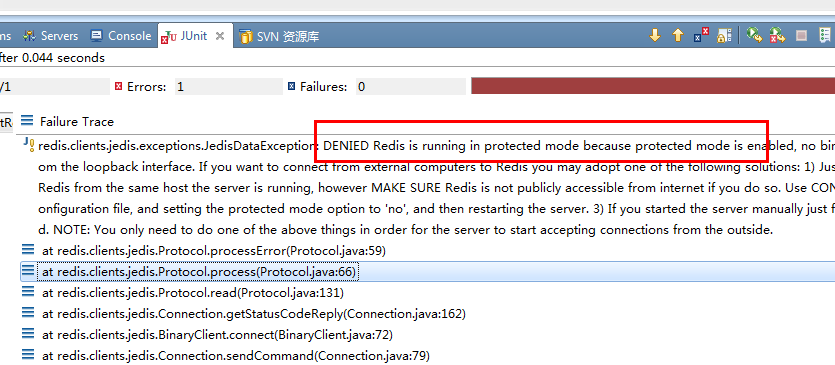【Springboot】——整合p6spy格式化SQL日志
项目现状介绍
项目使用Springboot+Mybatis作为基础框架,项目中日志框架采用logback+Slf4J,关于日志中SQL部分日志的打印采用的mybatis本身打印格式,sql语句正常输出,参数的位置使用占位符“?”替代。这样造成问题就是在处理项目中的sql问题,sql格式打印不规范,从sql日志查看,到sql日志运行判断都会花费一些重复的时间,既然这样那就想办法节省这一部分的时间吧。在Java项目中格式化sql日志,推荐使用辅助jar包,p6spy。
何为p6spy?
p6spy是针对数据库访问操作的动态监测框架(开源项目)它使得数据库数据可无缝截取和操纵,而不必对现有应用程序的代码作任何修改。P6Spy 分发包包括P6Log,它是一 个可记录任何 Java 应用程序的所有JDBC事务的应用程序。其配置完成使用时,可以进行数据访问性能的监测。
p6spy是一个可以用来在应用程序中拦截和修改数据操作语句的开源框架。 通过p6spy我们可以对SQL语句进行拦截,相当于一个SQL语句的记录器,这样我们可以用它来作相关的分析,比如性能分析等我们最需要的功能,查看sql语句,不是预编译的带问号的,而是真正的数据库执行的sql,更直观,更简单。
p6spy相关材料的获取途径
项目首页:http://p6spy.github.io/p6spy/
GitHub下载介绍页面:https://github.com/p6spy/p6spy/wiki/Download
GitHub托管地址:https://github.com/p6spy/p6spy/tree/master
帮助文档地址:http://p6spy.readthedocs.io/en/latest/
Springboot+Mybatis整合p6spy
#引入jar包<dependency><groupId>p6spy</groupId><artifactId>p6spy</artifactId><version>3.7.0</version></dependency>###引入配置文件spy.properties#### #%L# P6Spy# %%# Copyright (C) 2013 P6Spy# %%# Licensed under the Apache License, Version 2.0 (the "License");# you may not use this file except in compliance with the License.# You may obtain a copy of the License at## http://www.apache.org/licenses/LICENSE-2.0## Unless required by applicable law or agreed to in writing, software# distributed under the License is distributed on an "AS IS" BASIS,# WITHOUT WARRANTIES OR CONDITIONS OF ANY KIND, either express or implied.# See the License for the specific language governing permissions and# limitations under the License.# #L%##################################################################### P6Spy Options File ## See documentation for detailed instructions ## http://p6spy.github.io/p6spy/2.0/configandusage.html #################################################################################################################################### MODULES ## ## Module list adapts the modular functionality of P6Spy. ## Only modules listed are active. ## (default is com.p6spy.engine.logging.P6LogFactory and ## com.p6spy.engine.spy.P6SpyFactory) ## Please note that the core module (P6SpyFactory) can't be ## deactivated. ## Unlike the other properties, activation of the changes on ## this one requires reload. ###################################################################modulelist=com.p6spy.engine.spy.P6SpyFactory,com.p6spy.engine.logging.P6LogFactory,com.p6spy.engine.outage.P6OutageFactory################################################################# CORE (P6SPY) PROPERTIES ################################################################## A comma separated list of JDBC drivers to load and register.# (default is empty)## Note: This is normally only needed when using P6Spy in an# application server environment with a JNDI data source or when# using a JDBC driver that does not implement the JDBC 4.0 API# (specifically automatic registration).#driverlist=#####配置数据库驱动,根据自己的数据库选择driverlist=com.mysql.jdbc.Driver# for flushing per statement# (default is false)#autoflush = false# sets the date format using Java's SimpleDateFormat routine.# In case property is not set, miliseconds since 1.1.1970 (unix time) is used (default is empty)#dateformat=# prints a stack trace for every statement logged#stacktrace=false# if stacktrace=true, specifies the stack trace to print#stacktraceclass=# determines if property file should be reloaded# Please note: reload means forgetting all the previously set# settings (even those set during runtime - via JMX)# and starting with the clean table# (default is false)#reloadproperties=falsereloadproperties=true# determines how often should be reloaded in seconds# (default is 60)#reloadpropertiesinterval=60# specifies the appender to use for logging# Please note: reload means forgetting all the previously set# settings (even those set during runtime - via JMX)# and starting with the clean table# (only the properties read from the configuration file)# (default is com.p6spy.engine.spy.appender.FileLogger)###选择sql日志输出的问题 slf4jLogger输出到控制台,fileLogger输出到文件中appender=com.p6spy.engine.spy.appender.Slf4JLogger#appender=com.p6spy.engine.spy.appender.StdoutLogger#appender=com.p6spy.engine.spy.appender.FileLogger# name of logfile to use, note Windows users should make sure to use forward slashes in their pathname (e:/test/spy.log)# (used for com.p6spy.engine.spy.appender.FileLogger only)# (default is spy.log)###如果选择输出到文件中自定义文件的输出路径logfile = /data/www/logs/spy.log# append to the p6spy log file. if this is set to false the# log file is truncated every time. (file logger only)# (default is true)#append=true# class to use for formatting log messages (default is: com.p6spy.engine.spy.appender.SingleLineFormat)#logMessageFormat=com.p6spy.engine.spy.appender.MultiLineFormat#自定义日志格式,在类中定义,因为原生的p6spy日志格式虽然取代了“?”但是全部输出到一行,可读性差,还是建议自定义一下logMessageFormat=com.xxx.xxxx.common.datasource.P6Spy#logMessageFormat=com.p6spy.engine.spy.appender.SingleLineFormat# format that is used for logging of the date/time/... (has to be compatible with java.text.SimpleDateFormat)# (default is dd-MMM-yy)#databaseDialectDateFormat=dd-MMM-yy##输出时间格式databaseDialectDateFormat=yyyy-MM-dd HH:mm:ss# whether to expose options via JMX or not# (default is true)#jmx=true# if exposing options via jmx (see option: jmx), what should be the prefix used?# jmx naming pattern constructed is: com.p6spy(.<jmxPrefix>)?:name=<optionsClassName># please note, if there is already such a name in use it would be unregistered first (the last registered wins)# (default is none)#jmxPrefix=################################################################## DataSource replacement ## ## Replace the real DataSource class in your application server ## configuration with the name com.p6spy.engine.spy.P6DataSource ## (that provides also connection pooling and xa support). ## then add the JNDI name and class name of the real ## DataSource here ## ## Values set in this item cannot be reloaded using the ## reloadproperties variable. Once it is loaded, it remains ## in memory until the application is restarted. ## ###################################################################realdatasource=/RealMySqlDS#realdatasourceclass=com.mysql.jdbc.jdbc2.optional.MysqlDataSource################################################################## DataSource properties ## ## If you are using the DataSource support to intercept calls ## to a DataSource that requires properties for proper setup, ## define those properties here. Use name value pairs, separate ## the name and value with a semicolon, and separate the ## pairs with commas. ## ## The example shown here is for mysql ## ###################################################################realdatasourceproperties=port;3306,serverName;myhost,databaseName;jbossdb,foo;bar################################################################## JNDI DataSource lookup ## ## If you are using the DataSource support outside of an app ## server, you will probably need to define the JNDI Context ## environment. ## ## If the P6Spy code will be executing inside an app server then ## do not use these properties, and the DataSource lookup will ## use the naming context defined by the app server. ## ## The two standard elements of the naming environment are ## jndicontextfactory and jndicontextproviderurl. If you need ## additional elements, use the jndicontextcustom property. ## You can define multiple properties in jndicontextcustom, ## in name value pairs. Separate the name and value with a ## semicolon, and separate the pairs with commas. ## ## The example shown here is for a standalone program running on ## a machine that is also running JBoss, so the JDNI context ## is configured for JBoss (3.0.4). ## ## (by default all these are empty) ###################################################################jndicontextfactory=org.jnp.interfaces.NamingContextFactory#jndicontextproviderurl=localhost:1099#jndicontextcustom=java.naming.factory.url.pkgs;org.jboss.nameing:org.jnp.interfaces#jndicontextfactory=com.ibm.websphere.naming.WsnInitialContextFactory#jndicontextproviderurl=iiop://localhost:900################################################################# P6 LOGGING SPECIFIC PROPERTIES ################################################################## filter what is logged# please note this is a precondition for usage of: include/exclude/sqlexpression# (default is false)#filter=true# comma separated list of strings to include# please note that special characters escaping (used in java) has to be done for the provided regular expression# (default is empty)#include=select# comma separated list of strings to exclude# (default is empty)#exclude =# sql expression to evaluate if using regex# please note that special characters escaping (used in java) has to be done for the provided regular expression# (default is empty)#sqlexpression =#list of categories to exclude: error, info, batch, debug, statement,#commit, rollback and result are valid values# (default is info,debug,result,resultset,batch)#excludecategories=info,debug,result,resultset,batch#excludecategories=error,info,debug,result,resultset#excludecategories=info# Execution threshold applies to the standard logging of P6Spy.# While the standard logging logs out every statement# regardless of its execution time, this feature puts a time# condition on that logging. Only statements that have taken# longer than the time specified (in milliseconds) will be# logged. This way it is possible to see only statements that# have exceeded some high water mark.# This time is reloadable.## executionThreshold=integer time (milliseconds)# (default is 0)#executionThreshold=################################################################# P6 OUTAGE SPECIFIC PROPERTIES ################################################################## Outage Detection## This feature detects long-running statements that may be indicative of# a database outage problem. If this feature is turned on, it will log any# statement that surpasses the configurable time boundary during its execution.# When this feature is enabled, no other statements are logged except the long# running statements. The interval property is the boundary time set in seconds.# For example, if this is set to 2, then any statement requiring at least 2# seconds will be logged. Note that the same statement will continue to be logged# for as long as it executes. So if the interval is set to 2, and the query takes# 11 seconds, it will be logged 5 times (at the 2, 4, 6, 8, 10 second intervals).## outagedetection=true|false# outagedetectioninterval=integer time (seconds)## (default is false)#outagedetection=false# (default is 60)#outagedetectioninterval=30
自定义日志输出格式代码
import com.p6spy.engine.spy.appender.MessageFormattingStrategy;import java.text.SimpleDateFormat;import java.util.Date;public class P6Spy implements MessageFormattingStrategy {private SimpleDateFormat format = new SimpleDateFormat("yyyy-MM-dd HH:mm:ss:SSS");@Overridepublic String formatMessage(int connectionId, String now, long elapsed, String category, String prepared, String sql) {return !"".equals(sql.trim()) ? this.format.format(new Date()) + " | took " + elapsed + "ms | " + category + " | connection " + connectionId + "\n " + sql + ";" : "";}}
修改数据源,因为项目中配置了动态链接数据源,所以在代码中将返回Datasource的地方替换成P6Datasource
public DataSource createDataSource(DataSourceConfig dataSourceConfig, Map<String, Object> propertyMap) {Class<? extends DataSource> dataSourceType;try {dataSourceType = (Class<? extends DataSource>) Class.forName((String) "org.apache.tomcat.jdbc.pool.DataSource");DataSourceBuilder factory = DataSourceBuilder.create().driverClassName("com.mysql.jdbc.Driver").url(dataSourceConfig.getUrl()).username(dataSourceConfig.getUserName()).password(dataSourceConfig.getPassWord()).type(dataSourceType);ConversionService conversionService = new DefaultConversionService();DataSource dataSource = factory.build();RelaxedDataBinder dataBinder = new RelaxedDataBinder(dataSource);dataBinder.setConversionService(conversionService);dataBinder.setIgnoreNestedProperties(false);//falsedataBinder.setIgnoreInvalidFields(false);//falsedataBinder.setIgnoreUnknownFields(true);//truePropertyValues dataSourcePropertyValues = new MutablePropertyValues(propertyMap);dataBinder.bind(dataSourcePropertyValues);return new P6DataSource(dataSource);} catch (ClassNotFoundException e) {LOGGER.error("创建数据源失败", e);throw new RuntimeException(e);}}
添加前的SQL,添加之后的SQL日志

注意⚠️
p6spy本身配合slf4j+log4j使用,项目中需要整合logback,目前小编的项目还有一点不完美就是,sql.log日志文件不能自动自动切割,如果一定要利用logback来完成,p6spy打印的所有日志,输出到main函数所在的目录下。如果一定希望能自动切割,那就多关注一些main函数所在的包的日志切割情况。
总结
之前自己对技术的应用大部分停留到应用的层面,很片面的认为很少有机会去根据项目的需要改动现有框架的源码,所以会用就Ok了。但是这次在项目中整合p6spy,因为日志框架的问题,再加上对p6spy深入认知不够,还尚未完美的将p6spy+logback整合到一起。也让我反思对技术为什么要追求更高层次上的认知!
































还没有评论,来说两句吧...